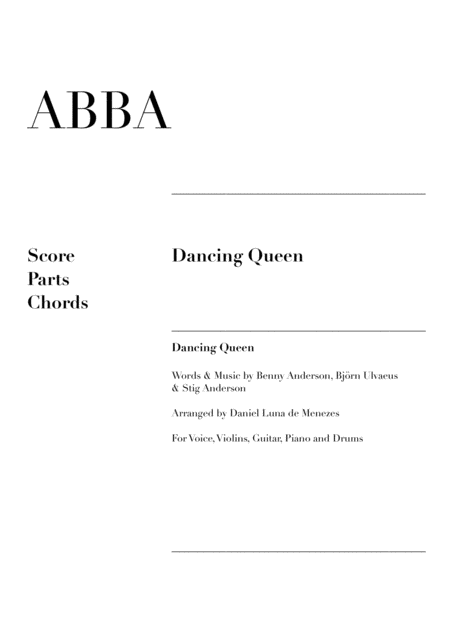Small Ensemble Drum Set,Guitar,Piano Accompaniment,Violin,Voice - Level 2 - Digital Download SKU: A0.914010 By ABBA. By Benny Andersson, Bjorn Ulvaeus, and Stig Anderson. Arranged by Daniel Luna de Menezes. Film/TV,Pop. Score and parts. 17 pages. Daniel Luna de Menezes #3563077. Published by Daniel Luna de Menezes (A0.914010). 2018 New ArrangeMe Song Contest EntryDancing Queen is a Europop song by the Swedish group ABBA, and the lead single from their fourth studio album, Arrival. It was written by Benny Andersson, Björn Ulvaeus and Stig Anderson. Andersson and Ulvaeus also produced the song. Dancing Queen was released as a single in Sweden on 15 August 1976, followed by a UK release and the rest of Europe a few days later. It was a worldwide hit. It became ABBA's only number one hit in the United States, and topped the charts in Australia, The Netherlands, Belgium, Ireland, Mexico, New Zealand, Norway, South Africa, Spain, Sweden, the United Kingdom, Germany and Zimbabwe. Dancing Queen also reached the Top 5 in many other countries.Musically, Dancing Queen is a Europop version of American disco music. As disco music dominated the US charts, the group decided to follow the trend, replicating Phil Spector's Wall of Sound arrangements. The song alternates between languid yet seductive verses and a dramatic chorus that ascends to heart-tugging high notes. It features keyboard lines by Andersson, which accentuate the melody's sophistication and classical complexity, while Ulvaeus and Andersson interlace many instrumental hooks in and out of the mix. Anni-Frid Lyngstad and Agnetha Fältskog's layered vocals have been noted for their dynamism, [negotiating] the melody's many turns flawlessly. Lyrically, the song concerns a visit to the discotheque, but approaches the subject from the joy of dancing itself.For the soundtrack of the 1994 Australian film Muriel's Wedding, songwriters Ulvaeus and Andersson allowed the use of Dancing Queen and other ABBA hits. Dancing Queen was among the ABBA songs included in Mamma Mia!, the jukebox musical first produced in 1999 and adapted into a movie released in 2008.
